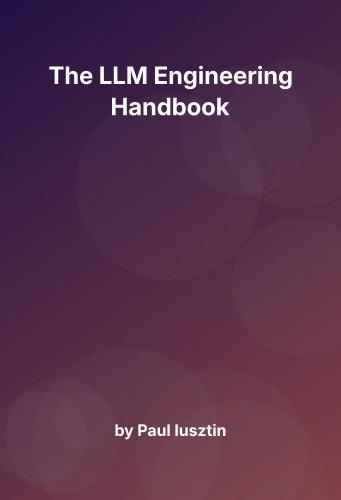The LLM Engineering Handbook: Strategic Insights for the Modern Professional
Introduction to LLM Engineering
In “The LLM Engineering Handbook,” Paul Iusztin presents a strategic playbook aimed at professionals eager to harness large language models (LLMs) for digital transformation. Unlike purely technical manuals, this handbook provides a roadmap that interweaves technology, strategy, and leadership for navigating contemporary business challenges. This approach positions LLMs not only as tools but as pivotal elements in driving innovation and enhancing organizational agility.
1. The Foundations of LLMs in Business
Understanding LLMs’ foundational principles is critical for integrating these technologies into business strategies. Iusztin demystifies the technical underpinnings of LLMs, explaining how they process and generate human-like text. This serves as a primer on natural language processing (NLP) and machine learning, setting the stage for more advanced applications. The emphasis on data quality and ethical considerations parallels discussions in “Weapons of Math Destruction” by Cathy O’Neil and “Artificial Intelligence: A Guide to Intelligent Systems” by Michael Negnevitsky. These works underscore the ethical dimensions and potential biases in AI applications, reinforcing Iusztin’s cautionary notes.
Real-World Example: Chatbots in Customer Service
To illustrate, consider a company deploying LLM-powered chatbots for customer service. The LLMs’ ability to understand and generate nuanced text can significantly improve customer interactions, reducing response times and increasing satisfaction. However, as Iusztin and O’Neil both highlight, ensuring the data that trains these models is unbiased and ethically sourced is paramount to avoid perpetuating existing prejudices.
2. Strategic Integration of LLMs
With a foundational understanding established, the focus shifts to the strategic integration of LLMs. Iusztin outlines a framework for evaluating LLMs’ potential impact on various business functions, stressing “LLM readiness.” This concept assesses an organization’s technological infrastructure, workforce skills, and cultural openness to innovation, drawing parallels to agile methodologies and their emphasis on adaptability.
Example: Agile Methodologies and LLMs
For instance, integrating LLMs into product development can streamline processes by automating routine tasks and providing data-driven insights. This mirrors principles from “The Lean Startup” by Eric Ries, which advocates for iterative product testing and development. By enhancing agility, LLMs allow teams to pivot quickly in response to market feedback, facilitating a more responsive and dynamic business environment.
3. Transformative Leadership in the Age of LLMs
Leadership plays a crucial role in successfully integrating LLMs. Iusztin emphasizes the need for visionary yet pragmatic leaders, who embody qualities like adaptability and empathy. Drawing from case studies, he provides insights on managing change and overcoming resistance, echoing themes from “Leaders Eat Last” by Simon Sinek, which underscores the importance of fostering trust and collaboration.
Leadership Model for the Digital Age
Iusztin introduces a leadership model tailored for the digital age, incorporating elements from transformational and situational leadership theories. This model is designed to guide leaders in creating environments conducive to innovation and continuous improvement, similar to models discussed in “The Innovator’s Dilemma” by Clayton Christensen.
4. Frameworks for Implementing LLM Solutions
Iusztin presents practical frameworks for implementing LLM solutions, tailored to various organizational needs. Key considerations include scalability, security, and compliance. The emphasis on a phased approach aligns with principles from “Good to Great” by Jim Collins, which stresses disciplined thought and action.
LLM Lifecycle Management
The “LLM Lifecycle Management” framework outlines stages from initial exploration to full-scale implementation and optimization. This lifecycle approach ensures adaptability to evolving technologies and market demands, akin to the continuous improvement models in “The Fifth Discipline” by Peter Senge, which focuses on learning organizations.
5. Measuring Success and Driving Continuous Improvement
The final sections focus on measurement and continuous improvement. Iusztin provides metrics and KPIs for evaluating LLM initiatives, emphasizing quantitative and qualitative assessments. This aligns with the lean startup methodology, which values feedback loops and iterative improvements.
Real-World Case Study: Implementing KPIs
Consider a tech startup launching an LLM-driven product. By setting clear KPIs, such as customer retention rates and satisfaction scores, the company can iteratively refine its offerings. This approach mirrors the iterative feedback mechanisms championed in “The Lean Startup.”
Final Reflection and Conclusion: Embracing the Future with Confidence
In synthesizing insights across technology, leadership, and strategic integration, “The LLM Engineering Handbook” offers a holistic approach to digital transformation. Iusztin’s strategic blueprint is enriched by comparisons to works like “The Innovator’s Dilemma” and “The Lean Startup,” providing a multidimensional perspective on leveraging LLMs.
The handbook encourages professionals to cultivate a culture of experimentation and learning. By integrating leadership theory, agile practices, and AI ethics, it equips organizations to embrace the future confidently and purposefully. Leaders are urged to foster an environment where failure is viewed as an opportunity for growth, echoing the adaptive leadership principles found in “The Fifth Discipline.”
In conclusion, Iusztin’s work is not only a guide for leveraging LLMs but a call to action for embracing innovation and transformation. By synthesizing insights from diverse domains, the handbook offers a robust framework for navigating the complexities of modern business landscapes.

